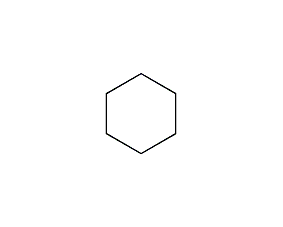
Structural formula
| Business number | 0326 |
|---|---|
| Molecular formula | C6H12 |
| Molecular weight | 84.16 |
| label |
Hexahydrobenzene, hexamethylene, 6 Hydrogen benzene, Hexahydrobenzene, Hexamethylene, Hexanaphthene, Extracting agent, Ester cyclic compounds and their derivatives |
Numbering system
CAS number:110-82-7
MDL number:MFCD00003814
EINECS number:203-806-2
RTECS number:GU6300000
BRN number:1900225
PubChem number:24853606
Physical property data
1. Properties: colorless liquid with pungent odor. [1]
2. Melting point (℃): 6.47[2]
3. Boiling point (℃): 80.7 [3]
4. Relative density (water = 1): 0.78[4]
5. Relative vapor density (Air=1): 2.90[5]
6. Saturated vapor pressure (kPa): 12.7 (20℃)[6]
7. Heat of combustion (kJ/mol): -3919.6[7]
8. Critical temperature (℃): 280.4[8]
9. Critical pressure (MPa): 4.05[9]
10. Octanol/water partition coefficient: 3.44[ 10]
11. Flash point (℃): -18 (CC) [11]
12. Ignition temperature (℃) ): 245[12]
13. Explosion upper limit (%): 8.4[13]
14. Explosion lower limit (%): 1.3[14]
15. Solubility: Insoluble in water, soluble in most organic solvents such as ethanol, ether, benzene, acetone and so on. [15]
16. Eccentricity factor: 0.212
17. Lennard-Jones parameter (A): 7.696
18. Lennard-Jones parameter (K): 575.1
19. Solubility parameter (J·cm-3)0.5: 16.700
20. van der Waals area (cm2·mol-1): 8.100×109
21 .van der Waals volume (cm3·mol-1): 61.400
22. Gas phase standard heat of combustion (enthalpy) (kJ·mol-1): -3952.76
23. Gas phase standard claims heat (enthalpy) (kJ·mol-1): -123.29
24. Gas phase standard entropy (J·mol-1·K-1): 297.39
25. Gas phase standard free energy of formation (kJ ·mol-1): 32.1
26. Gas phase standard hot melt (J·mol-1·K-1): 105.34
27. Liquid phase standard combustion heat (enthalpy) (kJ·mol-1): -3919.86
28. Liquid phase standard Claimed heat (enthalpy) (kJ·mol-1): -156.19
29. Liquid phase standard entropy (J·mol-1·K -1): 204.35
30. Liquid phase standard free energy of formation (kJ·mol-1): 26.72
31. Liquid phase standard hot melt (J·mol-1·K-1): 155.96
Toxicological data
1. Acute toxicity[16]
LD50: 12705mg/kg (rat oral)
LCLo:00%, the purity of cyclohexane depends on the purity of the raw material benzene. This method has been widely promoted.
4. Benzene is hydrogenated under the action of anhydrous ferric chloride catalyst. Then wash with sodium carbonate solution and obtain pure cyclohexane through distillation.
5. The preparation of BV-III cyclohexane mainly adopts the distillation process. The process route is: select appropriate industrial raw materials for distillation, ultra-clean filtration, and ultra-clean packaging to obtain the final product.
Purpose
1. This product is used as a solvent for rubber, coatings, and varnishes, a diluent for adhesives, and a grease extractant. Because this product has low toxicity, it is often used instead of benzene for degreasing, grease removal and paint removal. This product is mainly used to make nylon monomers adipic acid, hexamethylenediamine and caprolactam, and is also used as a raw material to make cyclohexanol and cyclohexanone.
2. Complex titration of copper, iron, silicon, aluminum, calcium, magnesium, etc. Chromatographic standards.
3. Cyclohexane is a cleaning and degreasing agent. MOS grade is mainly used for discrete devices, medium and large-scale integrated circuits, and BV-III grade is mainly used for very large-scale integrated circuits.
4. Used as analytical reagents, such as solvents and standard materials for chromatographic analysis.
5. The solubility performance is similar to that of hexane and benzene, but its toxicity is less than that of benzene. It can be used as a substitute, but the price is high. It is also used as a degreasing agent and paint coating peeling agent in industrial detergents. Agents, etc.
6. Used as a solvent for paint and resin, and a remover for paint and varnish.
7. Used as general solvent, standard material for chromatographic analysis and in organic synthesis. [28]

 微信扫一扫打赏
微信扫一扫打赏

